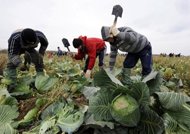 The UN food agency warned Monday that a quarter of the world’s landmass is “highly degraded,” making it difficult to meet the food needs of a booming population.
The UN food agency warned Monday that a quarter of the world’s landmass is “highly degraded,” making it difficult to meet the food needs of a booming population.
“Humankind can no longer treat these vital resources as if they were infinite,” said Jacques Diouf, head of the UN Food and Agriculture Organisation (FAO) based in Rome.
“The time for business as usual is over,” Diouf told reporters, calling the FAO’s assessment of the planet’s resources, a first for the organisation, a “wake-up call.”
The survey found that 25 percent of the world’s land is “highly degraded” and 44 percent is “moderately degraded,” while only 10 percent was classified as “improving”.
The categories in the report entitled “The State of the World’s Land and Water Resources for Food and Agriculture” (SOLAW) included classic soil and water degradation, as well as other aspects like biodiversity loss.
The report said land degradation was worst down the west coast of the Americas, across the Mediterranean region of southern Europe and north Africa, across the Sahel and the Horn of Africa and throughout Asia.
“Worldwide, the poorest have the least access to land and water and are locked in a poverty trap of small farms with poor-quality soils and high vulnerability to land degradation and climatic uncertainty,” it said.
Some 40 percent of degraded lands are found in high poverty areas.
The report called for more efficient water use by agriculture as well as innovative farming practices such as conservation agriculture, agro-forestry and integrated crop-livestock systems.
It said developing countries will need around $1.0 trillion (755 billion euros) in investments between 2007 and 2050 for irrigation. Land protection will require $160 billion over the same period, it added.
The FAO stressed that erosion, desertification and climate change were endangering key production systems across the world from the Mediterranean to southern Africa to Southeast Asia.
The publication coincided with the start of UN talks on climate change in Durban, South Africa, amid signs of a deepening political rift on how to slow the carbon juggernaut.
Topping the agenda of the talks is the fate of the Kyoto Protocol, the only global pact with targets for curbing greenhouse-gas emissions, whose first round of pledges expires at the end of 2012.
The conference must also push ahead with a “Green Climate Fund” to channel up to 100 billion dollars a year by 2020 to countries exposed to drought, flood, storms and rising seas, which scientists forecast will worsen.
The FAO said many farming areas “face the risk of progressive breakdown of their productive capacity under a combination of excessive demographic pressure and unsustainable agricultural use and practices.”
It said that between 1961 and 2009 the world’s cropland grew by 12 percent while farming production expanded 150 percent — mainly thanks to a significant increase in yields of major crops because of scientific advances.
But rates of productivity are now decreasing in many areas — key “warning signs” for the state of the land, the organisation said.
The worst indicator was for East Asia, where the FAO found that cereal production grew at an annual rate of 2.5 percent between 1961 and 2006 but was expected to advance by just 0.3 percent a year between 2006 and 2050.
Productivity has however increased in Central America and Eastern Europe.
The FAO said production would have to increase above the rate of population growth because of rising incomes and dietary changes, such as growing consumption of dairy and meat products in the developing world.
With pressure on natural resources, competition for land and water will become “pervasive” including between city and rural dwellers, the FAO said.
“These systems at risk may simply not be able to contribute as expected in meeting human demands by 2050. The consequences in terms of hunger and poverty are unacceptable,” Diouf said.


